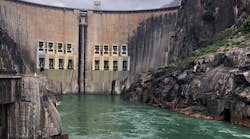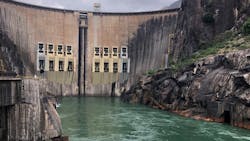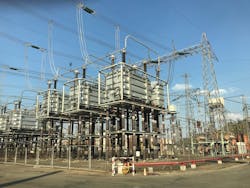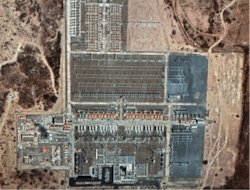The Cahora Bassa dam and hydroelectric power plant located on the Zambezi River in northern Mozambique was the last major construction project in Africa during the era of decolonization from Portugal. Commissioned in 1979, the Cahora Bassa is a 1920-MW, ±533.33-kV high-voltage direct-current (HVDC) bipolar system with four series groups per pole. The system links Mozambique’s Songo converter station to the Apollo inverter station near Johannesburg, South Africa, by a 1414-km (879-mile), 530-kV HVDC overhead transmission line.
This system experienced a long-term service interruption from 1985 to 1997 because of the Mozambican Civil War. “While the dam and power house were guarded during the war years, the effort extended on maintenance was minimal and was possible only for easily accessible parts of the plant,” according to the Cahora Bassa Comes Back to Life article published on May 11, 1998, by International Water Power & Dam Construction.
Since then, several upgrades have been made to the system, including the major refurbishment of the Apollo inverter station from 2006 to 2009. However, most of the equipment and systems at the Songo converter station are now more than 40 years old. They either are past their operational life or have been decommissioned because technical support is no longer provided by the original equipment manufacturers. As a result, system reliability and availability have decreased, while maintenance challenges at this converter station have increased.
System Refurbishment
In response to this challenging situation, Hidroeléctrica de Cahora Bassa (HCB), the owners and operators of the Cahora Bassa generation system and 2075-MW rated HVDC link, have begun the Brownfield Phase 3 (BF3) project. The objective of the BF3 project is to improve the overall performance of the Songo converter station by replacing and refurbishing the time-expired equipment and systems.
The high-level scope of work included in the BF3 project is as follows:
- Replace most equipment in the HVDC switchyard
- Replace and upgrade the Songo substation’s HVDC control and protection systems as well as the existing oil-cooled thyristor double valves, including the valve base electronics (VBE)
- Replace the earth electrode located near the Songo converter station
- Replace the 220-kV air-insulated substation (AIS) with a gas-insulated substation (GIS)
- Replace the grid master power controller (GMPC) with a new controller that includes the functionality of the existing controller but will also work with future generation and network developments.
Songo Converter Station
The existing Songo converter station layout is a classic bipolar-series group that provides operational flexibility. However, this flexibility has several shortcomings, most notably, the complexity of outdoor connections and complicated maintenance procedures for a modern quadra-valve, single-converter per-pole arrangement.
When assessing the condition of the converter and substation equipment, Canadian engineering consulting company Hatch identified that much of the equipment was well past its design and expected operational life. As a result, more frequent outages were needed to maintain the equipment in addition to the scheduled routine maintenance, thereby increasing the total maintenance cost. The scheduled outages were required to prevent more forced outages. Typically, they were conducted during periods of low utilization of the HVDC system to minimize power disruption.
The average availability and utilization of the Songo converter station from 2015 to 2018 averaged 83.7% — an availability performance some 13.3% below the typical 97% industry target. Furthermore, support from the original equipment manufacturers and the sourcing of replacement spare parts had become increasingly difficult.
Following this business case analysis, it was deemed necessary to completely refurbish the system as soon as possible. The refurbishment would include using the existing converter transformers, which had been upgraded recently as part of an earlier phase of the project, and replacing the existing oil-cooled valves.
BF3 Specifics
The BF3 project to refurbish the Songo converter station will be challenging, with the following key obstacles to overcome:
1. Concurrent generation refurbishment — Parallel to this project, the associated hydroelectric generation facility also will undergo a major refurbishment. The HVDC and generation refurbishment projects will need to be coordinated closely to minimize overall outages and maintain a high degree of availability to reduce disruptions to energy delivery and revenue.
2. GMPC — The Cahora Bassa HVDC system uses a GMPC, which ensures system stability and is responsible for balancing power flow through the HVDC system and the parallel weak alternating-current (ac) systems between Mozambique and South Africa. The new GMPC will have to be integrated as part of the refurbishment, while the old GMPC potentially operates in parallel with the new one. This added interface risk will need to be controlled tightly.
3. Interfacing with the Apollo inverter station — Located just outside of Johannesburg, the Apollo inverter station underwent an upgrade from 2006 to 2009. Therefore, the new equipment at the Songo converter station will have to interface with this equipment, which is now already 11 years old. Because of this added challenge, careful coordination between the equipment manufacturer and staff at both converter stations will be required.
The Cahora Bassa HVDC link is an especially important source of energy for the South African power system. Therefore, interruptions of the power transmission system must be minimized.
The key objectives of this capital-intensive project are as follows:
- Increase the overall availability of the large HVDC system to 97%
- Extend the remaining life of the Songo HVDC system by another 25 years
- Install the latest technology and train utility staff in the latest tools and techniques for the operation and maintenance of the entire plant and equipment.
A Case Study
The Songo converter station project is an ideal case study for the refurbishment of existing HVDC systems to enable the transmission of renewable energy resources. One of the largest issues with accessing renewable energy is the transmission system and distribution network upgrades required.
By reviewing and analyzing existing HVDC overhead line systems that require refurbishment or upgrading — or ac lines available for conversion to HVDC — it is possible to efficiently unlock the increased load-transfer capacity of existing HVDC and high-voltage ac (HVAC) transmission systems to meet the increasing demand for electrical energy.
Dan Kell ([email protected]), P. Eng., has a wide range of engineering experiences, including utility and international consultancy activities, with a focus on HVDC and flexible ac transmission systems and the integration of renewable energy. Kell currently serves as senior director, power system studies and eGrid in the Hatch HVDC Centre of Excellence. He has been involved in HVDC projects in key roles in Northern Ireland, Canada, the U.S., Mozambique, New Zealand, Australia and Germany. These projects have ranged from feasibility studies, technical specification preparation, tender review and commissioning to equipment assessments and studies involving equipment upgrades.





